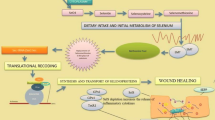Summary
We have recently demonstrated that 48 hour exposure of ROS 17/2 cells to low concentrations of 1,25-dihydroxycholecalciferol (1,25-(OH)2D3) (1.0 pg/ml) stimulated the cellular accumulation of45Ca, and exposure to high concentrations (160 pg/ml) inhibited such accumulation. In the present study, short-term (15 min) effects of the sterol on45Ca accumulation in ROS 17/2 cells were compared with the long-term (48 hours) effects in order to clarify mechanisms responsible for 1,25(OH)2D3 control of calcium metabolisms in ROS 17/2 cells. ROS 17/2 cells were grown for 48 hours in the presence and absence of 1,25(OH)2D3 and then incubated for an additional 15 min in the presence and absence of 1,25(OH)2D3 immediately before measuring45Ca accumulation. Cellular45Ca was measured after incubating the cells in the medium containing 0.5 μCi/ml of45CaCl2 for 4 min at 25°C. The effect of actinomycin D was determined by preincubating the cells in 0.1 μg/ml of actinomycin D for 45 min at 25°C. Exposure to low concentrations (1.0 pg/ml) of 1,25(OH)2D3 for either 48 hours or 15 min increased45Ca in the cells by 10–20%. An additional 15 min exposure following 48 hour exposure yielded an increase in the cellular45Ca similar to that after 48 hours or 15 min exposure. Exposure to high concentrations (160 pg/ml) for either 48 hour or 15 min decreased cell45Ca by approximately 20%.An additional 15 min exposure to the high concentrations did not change the 48 hour effect. Actinomycin D reversed early inhibitory effects of high concentrations, but had no effect on the early stimulatory effects of low concentrations. These results suggest that the mechanisms underlying the 15 min and 48 hour effects of 1,25(OH)2D3 are the same. Moreover, the mechanism responsible for the inhibitory effect of high concentrations is dependent onde novo protein synthesis whereas that for the stimulatory effects of low concentrations is not.
Similar content being viewed by others
References
Rodan GA, Martin TJ (1981) Role of osteoblasts in hormonal control of bone resorption—a hypothesis. Calcif Tissue Int 33:349–351
Partridge NC, Frampton RJ, Eisman JA, Michelangeli VP, Elms E, Bradley TR, Martin TJ (1980) Receptors for 1,25(OH)2 vitamin D3 enriched in cloned osteoblast like rat osteogenic sarcoma cells. FEBS Letters 115:139–142
Majeska RJ, Rodan SB, Rodan GA (1980) Parathyroid hormone-responsive clonal cell lines from rat osteosarcoma. Endocrinology 107:1494–1503
Boland CJ, Fried RN, Tasjian Jr HT (1986) Measurement of cytosolic free Ca2+ concentration in human and rat osteosarcoma cells: actions of bone resorption-stimulating hormones. Endocrinology 118:980–989.
Dokoh S, Donaldson CA, Haussler MR (1984) Influence of 1,25-dihydroxyvitamin D3 on cultured osteogenic sarcoma cells. Cancer Res 44:2103–2109
Kream BE, Joe M, Yamada S, DeLuca HF (1977) A specific high-affinity binding macromolecules for 1,25-dihydroxyvitamin D3 in fetal bone. Science 197:1086–1088
Kim YS, Birge SJ, Miller R, Avioli LV (1986) Vitamin-D mediated changes in the calcium accumulation in rat osteogenic sarcoma cells. Fed Proc 45:185
Lowry OH, Rosebrough NJ, Farr AL, Randall RJ (1951) Protein measurement with Folin phenol reagent. J Biol Chem 193:265–275
Bruning JL, Kintz BL (1977) Computational handbook of statistics, 2nd ed. Scott, Foresman and Company, Glenview, Illinois.
Eilam Y, Szydel N, Harell A (1980) Effect of vitamin D metabolites on cellular Ca2+ and on Ca transport in primary cultures of bone cells. Mol Cell Endocrinol 19:263–273
Raisz LG, Trummel CL, Holick MF, DeLuca HF (1972) 1,25-Dihydroxycholecalciferol: a potent stimulator of bone resorption in tissue culture. Science 175:768–769
Munck A, Crabtree GR, Smith KA (1979) Glucocosticoid receptors and actions in rat thymocytes and immunologically stimulated human peripheral lymphocytes. In: Baxter JD, Rousseau GG (eds) Glucocorticoid hormone action. Springer-Verlag, New York, p. 341
Voris BP, Young DA (1981) Glucocorticoid-induced proteins in rat thymus cells. J Biol Chem 256:11319–11329
Nemere I, Yoshimoto Y, Norman AW (1984) Calcium transport in perfused duodena from normal chicks: enhancement within fourteen minutes of exposure to 1,25 dihydroxyvitamin D3. Endocrinology 115:1476–1483
Bikle DD, Zolock DT, Morrissey RL, Herman RH (1978) Independence of 1,25 dihydroxyvitamin D-mediated calcium transport from de novo RNA and protein synthesis. J Biol Chem 253:484–488
Author information
Authors and Affiliations
Rights and permissions
About this article
Cite this article
Kim, Y.S., Birge, S.J., Avioli, L.V. et al. Early manifestations of vitamin D effects in rat osteogenic sarcoma cells. Calcif Tissue Int 41, 223–227 (1987). https://doi.org/10.1007/BF02555242
Received:
Revised:
Issue Date:
DOI: https://doi.org/10.1007/BF02555242




